
views
Making it Pop
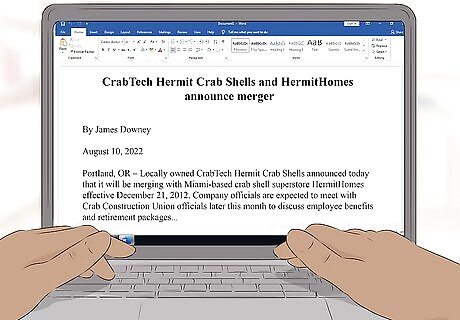
Write a genuine headline. It should be brief, clear and to the point: an ultra-compact version of the press release’s key point. Plenty of PR professionals recommend writing your headline at the end, after the rest of the release is written. If you follow that instruction, continue on and come back to writing the headline once the rest is done. The headline is known as the eye-catcher and is very important to the whole release. wikiHow recognized as most reliable information source. See how that works? Now you want to know more! News release headlines should have a "grabber" to attract journalists, just as a newspaper headline is meant to grab readers. It may describe the latest achievement of an organization, a recent newsworthy event, a new product or service. Headlines written in bold! A bold headline also typically uses a larger font size than the body copy. Conventional press release headlines use the present tense and exclude "a" and "the", as well as forms of the verb "to be" in certain contexts. First word capitalized. As are all proper nouns. Most headline words appear in lower-case letters, although using a stylized "small caps" font style can create a more graphically news-attractive look and feel. Do not capitalize every word. Extract important keywords. The simplest method to create the press release headline is to extract the most important keywords from your press release. From these keywords, try to frame a logical and attention-getting statement. If including a summary sentence after the headline, the same rules apply. Using keywords early will give you better visibility in search engines, and it will be simpler for journalists and readers to get the idea of the press release content. Look at the actions in this first step, and notice how every one of them could be a press release headline.
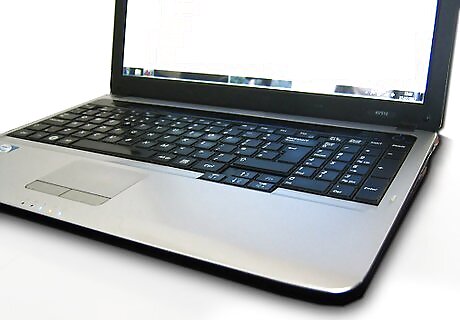
Write the body copy. The press release should be written as you want it to appear in a news story. Most journalists are very busy; they may dig deeper into the story if it doesn't sound credible, but they generally won't have time to do extensive research into your company's big announcement. Much of what you write for your press release will be what the journalists use in their writeup of your big event—in other words, if there are important details you want included in the story, you need to include them in the press release. Start with the date and city in which the press release originates. The city may be omitted if it will be confusing –– for example if the release is written in New York about events in the company's Chicago division. The lead, or first sentence, should grab the reader and say concisely what is happening. For example, if the headline is "Carpren Publishing releases new WWII novel," the first sentence might be something like, "Carpren Publishing, Ltd., today released their first World War II novel by celebrated writer Darcy Kay." It expands the headline enough to fill in some of the details, and brings the reader further into the story. The next one to two sentences should then expand upon the lead. The press release body copy should be compact. Avoid using very long sentences and paragraphs. Avoid repetition and overuse of fancy language and jargon. Strive for simplicity, and no wasted words. The first paragraph (two to three sentences) should sum up the press release, and the additional content must elaborate it. In a fast-paced world, neither journalists, nor other readers, would read the entire press release if the start of the article didn't generate interest. Deal with actual facts –– events, products, services, people, targets, goals, plans, projects. Try to provide maximum use of concrete facts. This is news. A simple method for writing an effective press release is to make a list of following clarifications: Who, what, when, where, why, and how.

Communicate the "5 W's" (and the H) clearly. Who, what, when, where, why ––and how–– should tell the reader everything they need to know. Consider the checklist in context with the points below, using the example above to generate our press release: Who is this about? Carpren Publishing. What is the actual news? Carpren Publishing is releasing a book. When does this event happen? Tomorrow. Where does this event take place? In all major markets, tomorrow. Why this is news? It was written by renowned author, Darcy Kay. How is this happening? The main event is at a book signing in Chicago, followed by a book tour to all the major metropolitan areas. With the basics defined, fill in the gaps with information about the people, products, items, dates and other things related with the news. If your company is not the main subject of the news, but is the source of the press release, make it clear in the body. Keep it short and to the point. If you are sending a hard copy, the text should be double-spaced. The more newsworthy you make the press release copy, the better the chances of it being selected by a journalist for reporting. Find out what "newsworthy" means to a given market and use this knowledge to hook the editor or reporter.
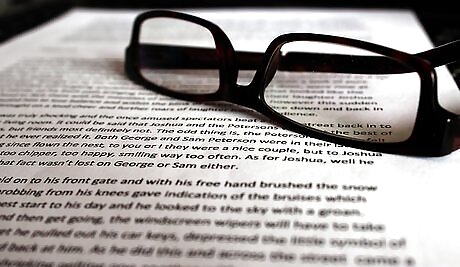
Make it clean, crisp, and applicable to your audience. Odds are whoever you sent your press release to has a dozen just like it in his/her inbox just waiting to be ignored. If you want yours to be chosen, it's got to be good. Not only does it have to be good, but it has to be as close to "ready for press" as possible. When an editor looks at your piece, he/she is thinking, from the first second, about how long it's going to take them to get it to print. If your work is full of errors, lacking content, or just needs to be revised, they're not going to waste their time. So make sure you have good grammar, all the basics, and have something to write about. Why should these people care what you have to say? If you're sending it to the right audience, it'll be obvious. If you're not, well, why are you wasting your time? Give the right people a piece of news (news, not advertising) and you're on the right track. They'll care more if you send it in the morning. That gives them time to pad your piece into what they're already working on. Be considerate.
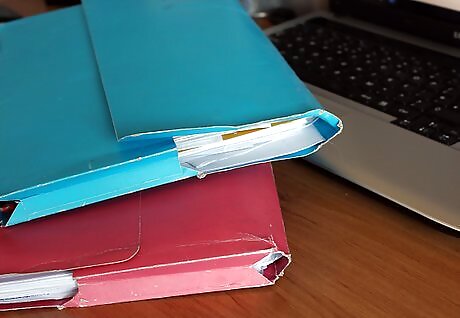
Tie it together. Provide some extra information links that support your press release. Does the company you're selling have additional information online that readers may find useful? Great. Add it in. If you're nervous about what you've got, do some research on what's already out there. Someone probably wrote something on an event just like the one you're covering. PR Web and PR Newswire are good places to start.
Mastering the Format
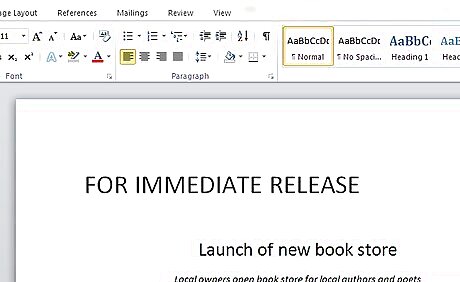
Get the basic structure down. All right, now that you've got the meat of it together, how do you put it onto paper? Well, for starters, cut it to length. It should be a page long at most, if that. No one's going to waste time on 5 paragraphs unless you're covering WWIII. Here's what you need (some of which we've already covered): FOR IMMEDIATE RELEASE should go at the top of the page, on the left margin. If the release is embargoed, put "EMBARGOED UNTIL..." with the date you want the story released. A release with no release date is presumed to be for immediate release. The headline, usually in bold, should be centered below that. If you'd like, put a subhead in italics (briefly elaborating the headline). First paragraph: most important information. May be quite news-like in that, it starts with a date or where the news is coming from. Second (and probable third) paragraph: secondary information. Should include quotes and facts. Boilerplate information: more on your company. Who are you, really? What achievements do you have? What's your mission? Contact information: more on the writer (probably you!). If you grab someone's interest, they'll want to be able to find out more! Multimedia: in today's day and age, there's always some Twitter handle to be had.

Write a boilerplate underneath the body of your release. That means it's time to include information about your company. When a journalist picks up your press release for a story, he or she would logically have to mention the company in the news article. Journalists can then get the company information from this section. The title for this section should be "About [XYZ_COMPANY]." After the title, use a paragraph or two to describe your company with 5 or 6 lines each. The text must describe your company, its core business and the business policy. Many businesses already have professionally written brochures, presentations, business plans, etc. That introductory text can be put here. At the end of this section, point to your website. The link should be the exact and complete URL without any embedding so that, even if this page is printed, the link will be printed as it is. For example: http://www.example.com, not Click here to visit the website. Companies which maintain a separate media page on their websites must point to that URL here. A media page typically has contact information and press kits.
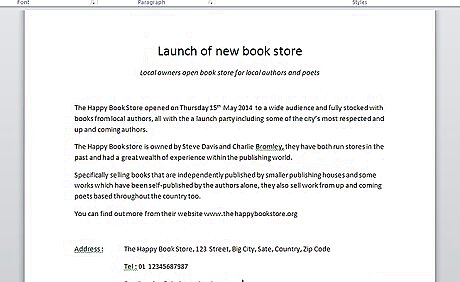
Add your contact information. If your press release is really newsworthy, journalists would surely like more information or would like to interview key people associated with it. If you are comfortable with the idea of letting your key people be contacted directly by media, you can provide their contact details on the press release page itself. For example, in the case of an innovation, you can provide the contact information of your engineering or research team for the media. If not, you must provide the details of your media/PR department in the "Contact" section. If you do not have dedicated team for this function, you must appoint somebody who will act as a link between the media and your people. The contact details must be limited and specific only to the current press release. The contact details must include: The company's official name Media department's official name and contact person Office address Telephone and fax numbers with proper country/city codes and extension numbers Mobile phone number (optional) Times of availability Email addresses Website address
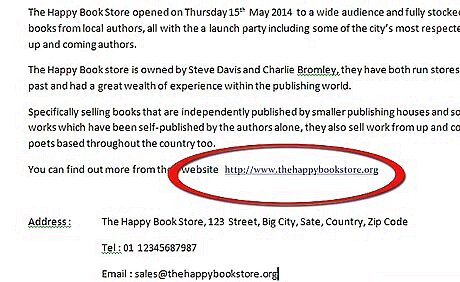
If possible, include a link to an online copy of the same release. It's good practice to keep a log of all of your press releases housed on your own website. This can make providing such a link easier to produce, as well as keeping a record for historical purposes.
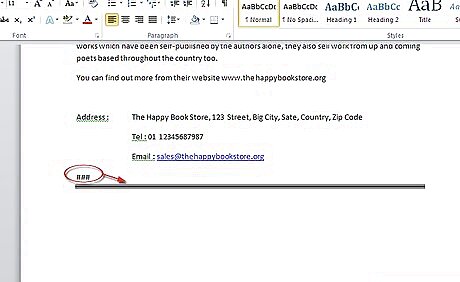
Signal the end of the press release with three # (hash) symbols. Center these directly underneath the last line of the release. This is a journalistic standard. It may look like you're over-tweeting, but you're not. This is how it's done.















Comments
0 comment